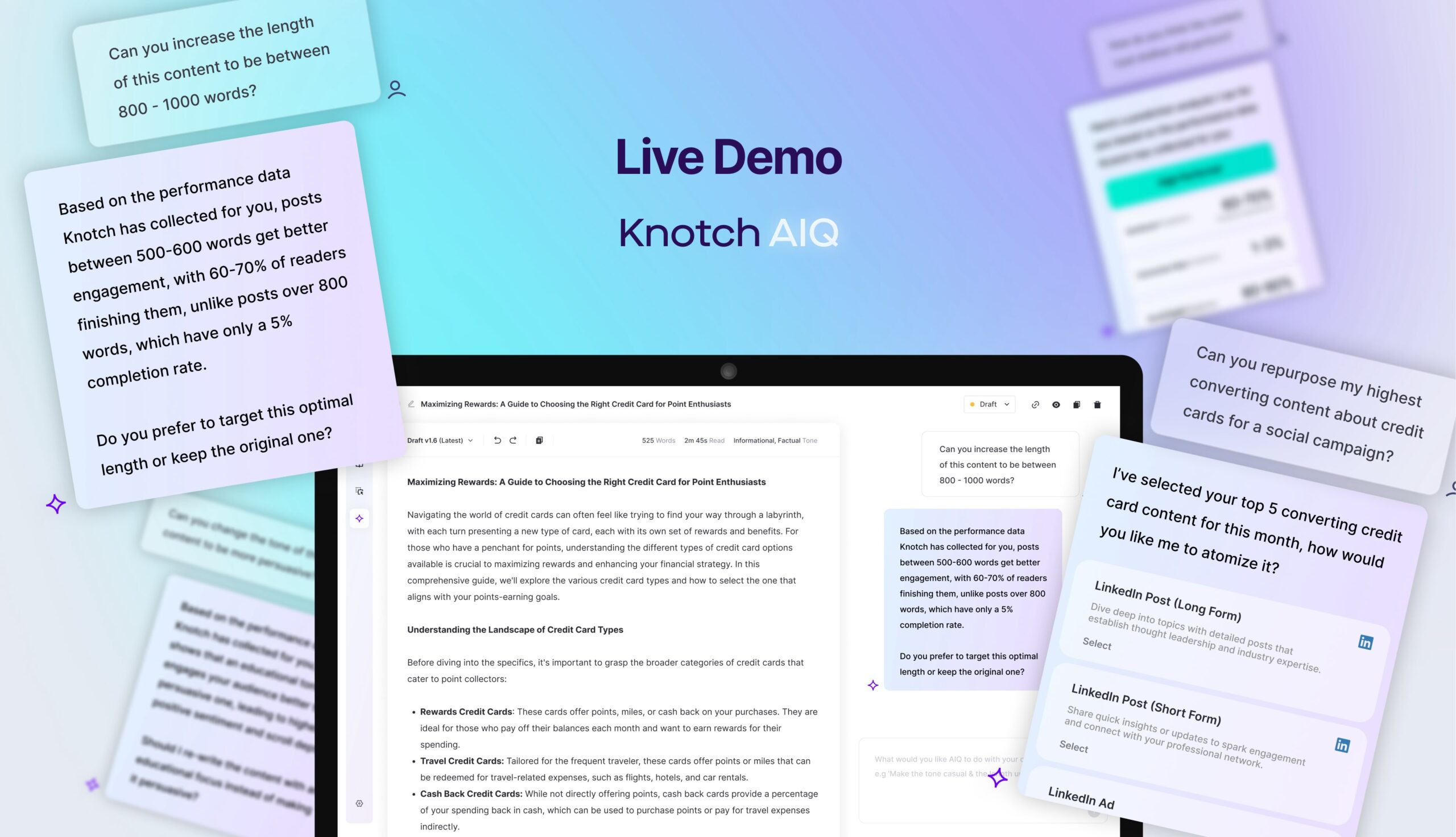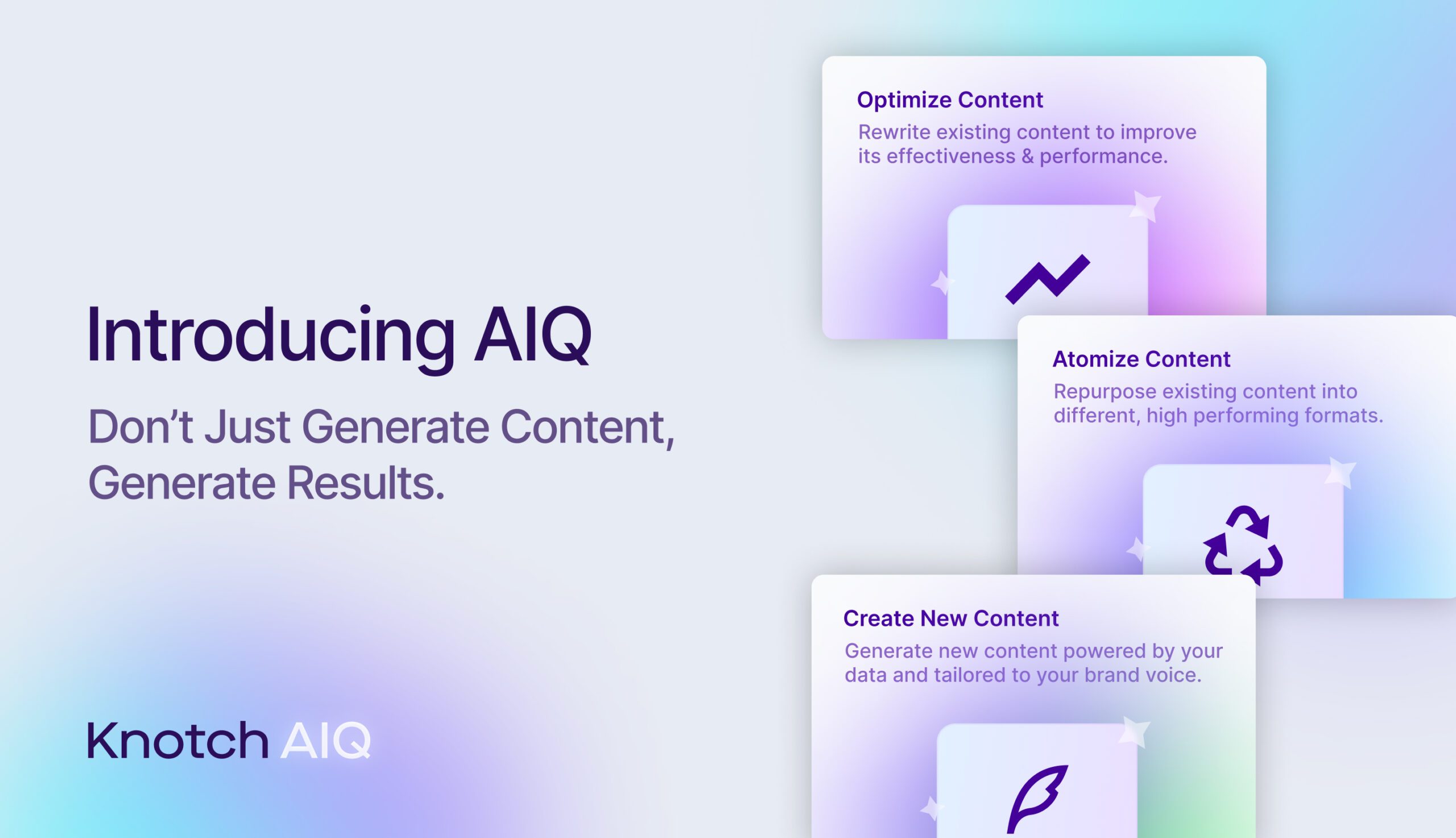How to improve content marketing in financial services
A growing number of financial services firms are investing in content marketing to build brand equity and stronger relationships with customers. But as banks and financial institutions invest more marketing dollars in content, CMOs and their teams need solutions that can help deliver better results by planning more effective campaigns, measuring content performance, and optimizing every asset.
Knotch is a content intelligence platform that offers powerful tools for financial content marketing, enabling marketing teams to get real-time performance metrics that can help to produce content that resonates and campaigns that deliver exceptional ROI.
The secret to content marketing in financial services
Content marketing is designed to build trust with audiences by providing access to valuable digital resources. Whether it’s a blog about wealth management, a video about managing cash in a small business, or an e-book on the best ways to save for retirement, content marketing in financial services can help institutions reach prospects and retain customers with content that informs, educates, and inspires.
Content marketing is costly, which makes it essential to measure performance accurately. Financial services firms need to maximize their spend on content by constantly optimizing pieces to increase their appeal and optimizing campaigns to increase their results. The secret to these efforts: content marketing analytics tools that can measure performance in real time, allowing teams to immediately take steps to revise or replace content that isn’t meeting expectations.
Even more important than real-time data is qualitative data that shows how audiences feel about the content they consume. Most digital marketing metrics are quantitative – they detail the number of unique visitors and page views, how deeply the user scrolled on content and how long they stayed on a site. What this data doesn’t reveal is whether the content improved audience perception of the brand and help to inspire greater trust.
While trustworthy audience sentiment data has been notoriously hard to come by, Knotch has found a way to deliver reliable data in real time.
Optimize content marketing in financial services with Knotch
Knotch is the independent content intelligence platform that helps CMOs and their teams measure and impact the outcome of content efforts with real-time, actionable intelligence across all content investments. The Knotch platform enables content teams to better plan, measure, optimize and benchmark efforts with a suite of easy-to-use tools in a SaaS-based solution.
To optimize content marketing for banks and financial institutions, Knotch provides an audience feedback unit that collects data on whether users like the content they are consuming or not. Appearing alongside each piece of content, the feedback unit provides a temperature scale that lets audiences register their feeling about content with a single click. By providing a way to express their sentiment about content at the same time they are consuming it, we have been able to exponentially increase response rates over traditional means for collecting audience feedback. Even more impressively, our audience sentiment data is delivered in real time to our customers, enabling them to move quickly to address issues and to optimize underperforming content.
Additionally, Knotch content analytics tools deliver:
- Comprehensive analysis of which content types, themes and distribution channels are the best performers, and how to optimize them in real time.
- Cross-platform comparisons using aggregated content analytics across all paid partnerships and owned content hubs.
- A holistic view of audience and performance data, combining audience sentiment feedback with quantitative data and audience demographics/psychographics.
- Actionable insights that enable teams responsible for content marketing in financial institutions to build more effective strategy, optimize assets and campaigns, and provide DMP and CRM platforms with enhanced segmentation for more personalized conversations.
What Knotch can do for financial institutions
With tools designed to improve content marketing for financial services, Knotch enables institutions to:
- Position the brand as a trusted advisor, a source of expertise, and the place to find helpful financial resources.
- Choose the publishers and content types best suited for driving desired responses that ladder up to brand goals.
- Build data-driven content experiences that direct key stakeholders to appropriate topics.
- Create content that drives high-value actions like opening accounts or contacting a financial advisor.
Comprehensive tools for content marketing in financial institutions
The Knotch platform also provides solutions for:
- Planning more effective campaigns with access to competitive analysis and a publisher matching tool that identifies the best partners based on KPIs, audience demographics and creative goals.
- Mapping customer journeys to take control of how users engage with content, tapping into their needs and interests to keep them on the site longer.
- Recommending the next, most valuable piece of content based on feedback collected during personalized conversations with users.
- Automatically organizing content libraries, classifying, tagging and indexing every content asset ever created and storing it under one roof for easier access.
- Automating the development of relevant content intelligence, surfacing insights that can be easily missed by marketers.
FAQs: what is content marketing in financial services?
What is content marketing in financial services?
Content marketing in financial services is the marketing discipline of creating digital content that target audiences will find helpful, with the objective of building greater trust and stronger relationships between the brand and customers/prospects.
How is success measured in content marketing in financial services?
Financial services content marketing teams need solutions for measuring performance that can deliver real-time data, which allows content teams to make adjustments immediately to improve performance and increase ROI. Content teams also need feedback on whether audiences like a piece of content or not, enabling teams to develop more resonant content that builds trust and improves brand perception.





